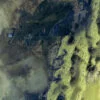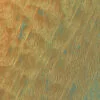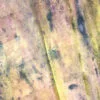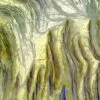When I was young, and just beginning to travel with them, I imagined that indigenous people saw more and heard more, that they were overall simply more aware than I was. They were more aware, and did see and hear more than I did. The absence of spoken conversation whenever I was traveling with them, however, should have provided me with a clue about why this might be true; but it didn’t, not for a while. It’s this: when an observer doesn’t immediately turn what his senses convey to him into language, into the vocabulary and syntactical framework we all employ when trying to define our experiences, there’s a much greater opportunity for minor details, which might at first seem unimportant, to remain alive in the foreground of an impression, where, later, they might deepen the meaning of an experience.
If my companions and I, for example, encountered a grizzly bear feeding on a caribou carcass, I would tend to focus almost exclusively on the bear. My companions would focus on the part of the world of which, at that moment, the bear was only a fragment. The bear here might be compared with a bonfire, a kind of incandescence that throws light on everything around it. My companions would glance off into the outer reaches of that light, then look back to the fire, back and forth. They would repeatedly situate the smaller thing within the larger thing, back and forth. As they noticed trace odors in the air, or listened for birdsong or the sound of brittle brush rattling, they in effect extended the moment of encounter with the bear backward and forward in time. Their framework for the phenomenon, one that I might later shorten just to ‘meeting the bear’, was more voluminous than mine; and where my temporal boundaries for the event would normally consist of little more than the moments of the encounter itself, theirs included the time before we arrived, as well as the time after we left. For me, the bear was a noun, the subject of a sentence; for them, it was a verb, the gerund ‘bearing’.
Over the years traveling cross-country with indigenous people I absorbed two lessons about how to be more fully present in an encounter with a wild animal. First, I needed to understand that I was entering the event as it was unfolding. It started before I arrived and would continue unfolding after I departed. Second, the event itself – let’s say we didn’t disturb the grizzly bear as he fed but only took in what he or she was doing and then slipped away – could not be completely defined by referring solely to the physical geography around us in those moments. For example, I might not recall something we’d all seen a half-hour before, a caribou hoof print in soft ground at the edge of a creek, say; but my companions would remember that. And a while after our encounter with the bear, say a half-mile farther on, they would notice something else – a few grizzly bear guard hairs snagged in scales of tree bark – and they would relate it to some detail they’d observed during those moments when we were watching the bear. The event I was cataloging in my mind as ‘encounter with a tundra grizzly’ they were experiencing as a sudden immersion in the current of a river. They were swimming in it, feeling its pull, noting the temperature of the water, the back eddies and where the side streams entered. My approach, in contrast, was mostly to take note of objects in the scene – the bear, the caribou, the tundra vegetation. A series of dots, which I would try to make sense of by connecting them all with a single line. My friends had situated themselves within a dynamic event. Also, unlike me, they felt no immediate need to resolve it into meaning. Their approach was to let it continue to unfold. To notice everything and to let whatever significance was there emerge in its own time.
The lesson to be learned here was not just for me to pay closer attention to what was going on around me, if I hoped to have a deeper understanding of the event, but to remain in a state of suspended mental analysis while observing all that was happening – resisting the urge to define or summarize. To step away from the familiar compulsion to understand. Further, I had to incorporate a quintessential characteristic of the way indigenous people observe: they pay more attention to patterns in what they encounter than to isolated objects. When they saw the bear they right away began searching for a pattern that was resolving itself before them as ‘a bear feeding on a carcass’. They began gathering various pieces together that might later self-assemble into an event larger than ‘a bear feeding’. These unintegrated pieces they took in as we traveled – the nature of the sonic landscape that permeated this particular physical landscape; the presence or absence of wind, and the direction from which it was coming or had shifted; a piece of speckled eggshell under a tree; leaves missing from the stems of a species of brush; a hole freshly dug in the ground – might individually convey very little. Allowed to slowly resolve into a pattern, however, they might become revelatory. They might illuminate the land further.
If the first lesson in learning how to see more deeply into a landscape was to be continuously attentive, and to stifle the urge to stand outside the event, to instead stay within the event, leaving its significance to be resolved later; the second lesson, for me, was to notice how often I asked my body to defer to the dictates of my mind, how my body’s extraordinary ability to discern textures and perfumes, to discriminate among tones and colors in the world outside itself, was dismissed by the rational mind.
As much as I believed I was fully present in the physical worlds I was traveling through, I understood over time that I was not. More often I was only thinking about the place I was in. Initially awed by an event, the screech of a gray fox in the night woods, say, or the surfacing of a large whale, I too often moved straight to analysis. On occasion I would become so wedded to my thoughts, to some cascade of ideas, that I actually lost touch with the details that my body was still gathering from a place. The ear heard the song of a vesper sparrow, and then heard the song again, and knew that the second time it was a different vesper sparrow singing. The mind, pleased with itself for identifying those notes as the song of a vesper sparrow, was too preoccupied with its summary to notice what the ear was still offering. The mind was making no use of the body’s ability to be discerning about sounds. And so the mind’s knowledge of the place remained superficial.
Many people have written about how, generally speaking, indigenous people seem to pick up more information traversing a landscape than an outsider, someone from a culture that no longer highly values physical intimacy with a place, that regards this sort of sensitivity as a ‘primitive’ attribute, something a visitor from an ‘advanced’ culture would be comfortable believing he had actually outgrown. Such a dismissive view, as I have come to understand it, ignores the great intangible value that achieving physical intimacy with a place might provide. I’m inclined to point out to someone who condescends to such a desire for intimacy, although it might seem rude, that it is not possible for human beings to outgrow loneliness. Nor can someone from a culture that condescends to nature easily escape the haunting thought that one’s life is meaningless.
Existential loneliness and a sense that one’s life is inconsequential, both of which are hallmarks of modern civilizations, seem to me to derive in part from our abandoning a belief in the therapeutic dimensions of a relationship with place. A continually refreshed sense of the unplumbable complexity of patterns in the natural world, patterns that are ever present and discernible, and which incorporate the observer, undermine the feeling that one is alone in the world, or meaningless in it. The effort to know a place deeply is, ultimately, an expression of the human desire to belong, to fit somewhere.
The determination to know a particular place, in my experience, is consistently rewarded. And every natural place, to my mind, is open to being known. And somewhere in this process a person begins to sense that they themselves are becoming known, so that when they are absent from that place they know that place misses them. And this reciprocity, to know and be known, reinforces a sense that one is necessary in the world.
Perhaps the first rule of everything we endeavor to do is to pay attention. Perhaps the second is to be patient. And perhaps a third is to be attentive to what the body knows. In my experience, individual indigenous people are not necessarily more aware than people who’ve grown up in the modern culture I grew up in. Indigenous cultures, of course, are as replete with inattentive, lazy, and undiscerning individuals as ‘advanced’ cultures. But they tend to value more highly the importance of intimacy with a place. When you travel with them, you’re acutely aware that theirs is a fundamentally different praxis from your own. They’re more attentive, more patient, less willing to say what they know, to collapse mystery into language. When I was young, and one of my traveling companions would make some stunningly insightful remark about the place we were traveling through, I would sometimes feel envious; a feeling related not so much to a desire to possess that same depth of knowledge but a desire to so obviously belong to a particular place. To so clearly be an integral part of the place one is standing in.
A grizzly bear stripping fruit from blackberry vines in a thicket is more than a bear stripping fruit from blackberry vines in a thicket. It is a point of entry into a world most of us have turned our backs on in an effort to go somewhere else, believing we’ll be better off just thinking about a grizzly bear stripping fruit from blackberry vines in a thicket.
The moment is an invitation, and the bear’s invitation to participate is offered, without prejudice, to anyone passing by.
Image © Nick Clements, Grizzly from the Darkness series, courtesy of SaatchiArt.com








